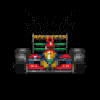Part3: Rear wing
The rear wing has an important component for producing the “cleaner” wake desired by the 2022 rules. As Nikolas Tombazis (the FIA’s head of single seater matters and final author of the 2022 regulations) told the
FIA’s Auto Journal in 2018,
The rear wing helps us when we’re trying to promote closer racing. It has two strong trailing vortices, which pull the flow up from close to the ground into the ‘mushroom’. This mushroom is pushed upwards quite violently and quickly, allowing clean air to be pulled in from the sides to take the place of the turbulent air being flung upwards. This clean air tends to be higher energy, which has a beneficial effect on the aerodynamics of the following car.”
To this end the rear wing is larger than the rear wings of the 2017-21 cars, with a wider span (1230mm vs 1050mm) and longer chord (415mm vs 350mm). The aspect ratio (

) of the wing is a little bit smaller as a result, which in turn will slightly increase the strength of the trailing vortices. The lack of a traditional endplate will also help high pressure air from the upper surface of the wing to leak around the side. The rear wing is also a little further from the ground, 910mm compared to 870mm at the top.

The rear wing is split up in a similar way to the front wing, with separate volumes for the wing profiles, endplate, and a blended section to join the two. There is also a lower “beam” wing which was outlawed in 2014 to cut the rear downforce of the cars.
- RV-RWEP-BODY Rear Wing Endplate Reference Volume
- RV-RW-PROFILES Rear Wing Profiles Reference Volume
- RV-RW-TIP Rear Wing Tip Reference Volume
- RV-RW-BEAM Rear Wing Beam Reference Volume
- RV-RW-PYLON Rear Wing Pylon Reference Volume
- RS-RW-RWEP Rear Wing Endplate Reference Surface
- RS-RW-BEAM Rear Wing Beam Reference Surface
As mentioned RV-RW-PROFILES (grey below) is longer than the current rear wing box, it is also slightly taller which will increase the camber possible from the rear wing for more downforce. More downforce strengthens the tip vortices, which as already described are important for the cleaner wake. Inside RV-RW-PROFILES the definition is similar to the front wing profiles, the number of elements is limited, in this case to two, with minimum concave radius of curvature on the aerofoil (100mm) and slot gap separations (10-15mm). Across the span the wing profiles cannot subtend by an angle greater than 20°, meaning that “spoon” shaped wings cannot be too aggressive, though as the FIA renders show the wings can still be fairly spoon shaped.

Rear wing endplates have become evermore complex since 2017 with numerous slots and vanes hanging underneath the wing profiles. For 2022 the endplate is being significantly simplified with only a single closed section (no holes or slots) permitted inside RV-RW-RWEP (purple above and below). The endplate will continue to narrow from top to bottom, to avoid fouling the rear tyre and brake ducts. While from the side projection the endplate must be bigger than RS-RW-RWEP (green below). There are not many other rules regarding the shape of the endplate but for a minimum curvature of 100mm. Despite the
swoopy shape the rear wing endplates will still have to display the ERS/rain warning lights between 500mm and 870mm from the ground.
Like the front wing, RV-RW-TIP (red above) exists to smoothly blend the aerofoil profiles into the endplate. There are many rules for this tip region, but the important one is that the arc of the blend must be bigger than a radius of 20mm, like the front wing tip, to prevent sharp corners.

Returning for 2022 is the lower beam wing (RV-RW-BEAM, light blue above) which aids extraction of flow from the underbody tunnels by lowering the static pressure at the base of the car. The beam wing rules are similar to the other wing profile sections, with a maximum number of elements (two), a minimum concave curvature (50mm), and maximum angles of subtension across the span (15° when further than 175mm from

and 60° for bodywork less than 175mm from

). To prevent the beam wing influencing the exhaust plume, no part of the beam wing may be within 10mm of the exhaust tailpipe. Finally the beam wing must leave no more than 80,000mm² of RS-RW-BEAM (orange below) visible when viewed from above - in other words covering at least 38% of the surface area of RS-RW-BEAM. To support the wing assembly no more than two pylons can be within RV-RW-PYLON (dark grey above). The overlap and small intersection between RV-RW-PROFILES and RV-RW-PYLON means a swan-neck type wing hanger will be the norm.

There has been some confusion as to whether the rear wing Drag Reduction System (DRS) overtaking aid will be retained in 2022, mostly because none of the renders released by FOM have shown it. Currently DRS is included in the rules, with the same 85mm letterbox as now. The opening section of the wing can only be up to 480mm from

(the width of RV-RW-PROFILES) with the actuator fitting inside a cuboid measuring 60x30x30mm (LxWxH), though it can lie outside RV-RW-PROFILES and RV-RW-PYLON. The hinge about which rotation is achieved must be less than 20mm forward and up to 20mm below the trailing edge of the flap.







